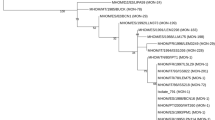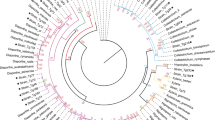Abstract
Thirty-eight Leishmania isolates from different host species (humans, mammals, reptiles and sandflies) from various parts of Kenya-were compared with six World Health Organization Leishmania reference strains. Isoenzyme variations were assessed on the basis of their electrophoretic profiles on cellulose acetate membranes. Out of 18 enzymes studied, five were selected for differentiating the Leishmania isolates. These were glucose-6-phosphate dehydrogenase (G6PD, E.C. 1.1.1.49), glucose phosphate isomerase (GPI, E.C. 5.3.1.9), malate dehydrogenase (MDH, E.C. 1.1.1.37), mannose phosphate isomerase (MPI, E.C. 5.3.1.8) and phosphoglucomutase (PGM, E.C. 2.7.5.1).
Twenty-one isolates showed enzymatic patterns identical to the Leishmania reference strain Leishmania major IC-236, five isolates were similar to the Leishmania reference strain L. donovani IC-245 and three isolates were identical to the Leishmania reference strain L. aethiopica IC-228.
However, nine Leishmania isolates could not be identified by this method. They are either leishmanial species for which more Leishmania reference strains are needed for comparison or unidentified flagellates species.
The banding patterns revealed by L. major IC-235, isolated from Israel, were different from those of L. major IC-236, isolated from Kenya, with respect to G6PD; GPI; MDH; MPI and PGM.
Résumé
Trente-huit nouveaux isolats de Leishmania de différentes origines humaine et animale (hommes, chats sauvages, chèvres, lézards et phlébotomes) obtenus à travers le Kenya sont comparés avec des souches de référence de l’Organisation Mondiale de la Santé.
Les variations isoenzymatiques ont été déterminées en se basant sur leurs profils électrophorétiques sur membrane d’acétate de cellulose. Des dix-huit enzymes analysés, cinq ont été séléctionnés pour différencier les isolats de Leishmania. Il s’agit du glucose-6-phosphate déshydrogenase (G6PD, E.C. 1.1.1.49), glucose phosphate isomerase (GPI, E.C. 5.3.1.9), malate déshydrogenase (MDH, E.C. 1.1.1.37), mannose phosphate isomerase (MPI, E.C. 5.3.1.8) et phosphoglucomutase (PGM, E.C. 2.7.5.1).
Vingt et un isolats ont montré des profils enzymatiques identiques à ceux de la souche de référence Leishmania major IC-236, cinq étaient similaires à la souche de référence L. donovani IC-245 et trois isolats étaient identiques à la souche de référence L. aethiopica IC-228.
Cependant neuf isolats n’ont pas pu être identifiés par la méthode utilisée. Ils sont probablement identiques aux espèces déjà connues pour lesquelles des souches de référence sont nécessaires pour la comparaison ou d’autres espèces flagellées non identifiées de la famille de Kinoplastidae.
Les données présentées dans cet article indiquent aussi que les profils électrophorétiques obtenus avec la souche de référence L. major IC-235 en provenance d’Israël étaient très différents de ceux obtenus avec la souche de référence L. major IC-236 originaire du Kenya par rapport aux enzymes G6PD; GPI; MDH; MPI et PGM. Les implications épidémiologiques de ces données ont été discutées.
Similar content being viewed by others
References
Aljeboori T. I. and Evans D. A. (1980) Leishmania spp. in Iraq. Electrophoretic isoenzyme patterns. Visceral leishmaniasis. Trans. R. Soc. Trop. Med. Hyg. 74, 169–177.
Allsopp B. A., Jones A., Allsopp M. T. E., Newton S. D. and Macpherson C. N. L. (1987) Interspecific characterization of several taeniid cestodes by isoenzyme analysis using isoelectric focusing in agarose. Parasitology 95, 593–601.
Ferguson C. (1987) Leishmaniasis debilitating, disfiguring and sometimes deadly. The International Development Research Centre, Reports. 16 No. 4 pp. 23.
Gibson W. C., Mehlitz D., Lanham S. M. and Godfrey D. G. (1978) The identification of Trypanosome brucei gambiense in Liberian pigs and dogs by isoenzymes and by resistance to human plasma. Tropenmed. Parasitol. 29, 335–345.
Gibson W. C, Parr C. W., Swindlehurst C. A. and Welch S. G. (1978) A comparison of the isoenzymes, soluble proteins polypeptides and free amino acids from ten isolates of Trypanosoma evansi. Comp. Biochem. Physiol. 60B, 137–142.
Githure J., Schnur L. F., Le Blancq S. M. and Hendricks L. D. (1986) Characterization of Kenyan Leishmania spp. and the identification of Mastomys natalensis, Tarterillus emini and Aethomys kaiseri as new hosts of Leishmania major. Ann. Trop. Med. Parasitol. 80, 501–507.
Godfrey D. G. and Kilgour V. (1976) Enzyme electrophoresis in characterizing the causative organisms of Gambian trypanosomiasis. Trans. R. Soc. Trop. Med. Hyg. 70, 219–224.
Gomez-Eichelman C. M., Holz Jr. G., Beach D., Simpson A. M. and Simpson L. (1988) Comparison of several lizard Leishmania species and strains in terms of kinetoplast minicirele and maxicirele DNA sequences, nuclear chromosomes and membrane lipids. Mol. Biochem. Parasitol. 27, 143–158.
Kreutzer R. D. and Christensen H. A. (1980) A comparison of electrophoretic methods for isoenzyme characterization of trypanosomatids. I: Standard stocks of Trypanosoma cruzi zymodemes from northeast Brazil. Am. J. Trop. Med. Hyg. 29, 199–208.
Kruger F. J. (1988) Further observations on the electrophoretic characterization of South Africa Schistosoma mattheei and Schistosoma haematobium. Onderstepoort J. Vet. Res. 55, 67–68.
Lanham S. M, Grendon J. M., Miles M. A., Povoa M. M. and Almeida De Souza A. A. (1981) Characterization of Leishmania spp. by isoenzyme electrophoresis. Trans. R. Soc. Trop. Med. Hyg. 75, 742–750.
Le Blancq S. M. and Peters W. (1986) Leishmania in the Old World: 4. The distribution of L. donovani sensu lato zymodemes. Trans. R. Soc. Trop. Med. Hyg. 80, 367–377.
Le Blancq S. M., Schnur L. F. and Peters W. (1986) Leishmania in the Old World: 1. The geographical and hostal distribution of L. major zymodemes. Trans. R. Soc. Trop. Med. Hyg. 80, 99–112.
Letch C. A. and Gibson W. (1981) Trypanosome brucei: the peptidases of blood stream trypanosomes. Exp. Parasitol. 52, 86–90.
Macpherson C. N. L. and MacManus D. P. (1982) A comparative study of Echinococcus granulosus from human and animal hosts in Kenya using isoelectric focusing and isoenzyme analysis. Int. J. Parasitol. 12, 515–521.
Majiwa P. A. O., Hamers R., Van Meirvenne N. and Matthyssens G. (1986) Evidence for genetic diversity in Trypanosoma (Nannomonas) congolense. Parasitology 93, 291–304.
Muigai R., Githure J. I., Gachihi G. S., Were J. B. O., Leeuwenburg J. and Perkins P. V. (1987) Cutaneous leishmaniasis caused by Leishmania major in Baringo District, Kenya. Trans. R. Soc. Trop. Med. Hyg. 81, 600–602.
Mutinga M. J. and Ngoka J. M. (1983) Investigation of animal reservoirs of visceral leishmaniasis and the isolation of Leishmania major in Marigat, Baringo. District, Kenya. Insect Sci. Applic. 4, 237–240.
Mutinga M. J., Mutero C. M., Ngindu A. and Amimo F. A. (1988) The isolation of leishmanial parasites from domestic goats and wild hosts and possible role of goats as reservoirs of leishmaniasis. Insect Sci. Applic. 9, 339–344.
Mutinga M. J., Kihara S. M., Lohding A., Mutero C. M., Ngatia T. A. and Karann F. (1989) Leishmaniasis in Kenya: description of leishmaniasis of a domestic goat from Transmara, Narok District, Kenya. Trop. Med. Parasitol. 40, 91–96.
Okot-Kotber B. M. (1985) A rapid chromatographic method for elimination of fungal contamination in “in vitro” cultures of Leishmania spp. Parasitology 91, 1–7.
Okot-Kotber B. M., Mutinga M. J. and Kaddu J. B. (1989) Biochemical characterization of Leishmania spp. isolated from man and wild animals in Kenya. Int. J. Parasitol. 19, 657–663.
Riou G. F. and Yot P. (1977) Heterogeneity of the kinetoplast DNA molecules of Trypanosoma cruzi. Biochemistry 16, 2390–2396.
Ross G. C. (1977) Analysis by isoelectric focusing of phosphoglucose isomerase in Schistosoma species and their snail hosts. Proceedings of the Analytical Division of the Chemical Society, 76–79.
Schottelius J. (1982) Lectin binding strain-specific carbohydrates on the cell surfaces of Leishmania strains from the Old World. Zeit. Parasit. 66, 237–247.
Simpson L. and Simpson A. M. (1978) Kinetoplast DNA of Leishmania tarentolae. Cell 14, 169–178.
UNDP/World Bank/WHO Special Programme for Research and Training in Tropical Diseases (TDR) (1987) Eighth Programme Report pp. 99–111.
Author information
Authors and Affiliations
Rights and permissions
About this article
Cite this article
Massamba, N.N., Mutinga, M.J. & Odero, B.N. Characterization of Kenyan Isolates of Leishmania by Cellulose Acetate Electrophoresis. Int J Trop Insect Sci 14, 153–161 (1993). https://doi.org/10.1017/S1742758400014545
Received:
Accepted:
Published:
Issue Date:
DOI: https://doi.org/10.1017/S1742758400014545
Key Wards
- Leishmania isolates
- reference strains
- enzyme typing
- Leishmania major
- Leishmania aethiopica
- Leishmania donovani




